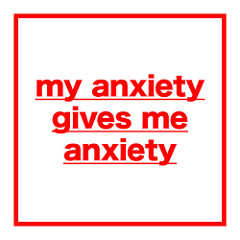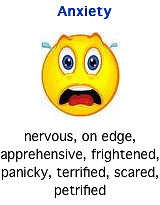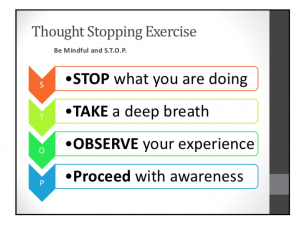Sex and anxiety are often tied closely together with clients seeking out sex therapy presenting also with anxiety issues. Anxiety is often the most commonly found emotion tied into sex and sexual dysfunction, and it is important that we address anxiety issues just as much as we address sex issues as issues with sex and anxiety are so closely linked.
Recently, Melissa Hargrave, LPC-S, L-MFT (2018) presented on “The Intersection of Sex & Anxiety: Your Roadmap to Getting Smart About Sex Related Anxiety” at the American Association for Sex Educators, Counselors, and Therapists (AASECT) Meet & Greet held in Austin, TX on February 9, 2018.
Additionally, I’ve had the pleasure to work with Dr. Michael Telch, of the University of Texas Laboratory for the Study of Anxiety Disorders (utanxiety.com) and have added some of his ideas and research in this blog as well.
Here are some thoughts about sex and anxiety and how they interact so closely and can be a major factor that contributes to sexual dysfunction. First, we will start with a working definition of what is anxiety.
What is Anxiety?
Anxiety is the response to a perceived threat and subsequent false alarm. Basically, when we perceive a threat, our bodies natural inclination is to respond with anxiety or panic (anxiety is a perceived threat in the near or distant future, panic is a perceived threat that is imminent or immediate). But if the threat is exaggerated, not real, or bogus, that results in a false alarm.
Anxiety is anticipation of future threat, with apprehension and fear, as characterized by symptoms in our body, our thoughts, and behaviors. Our bodies fear response is a learned response, and can trigger anxiety.
When we learn a fear response to something in sex (because of a traumatic event or other issue) or if our body responds with false alarms to perceived but bogus threats (my marriage will be over if I don’t have sex), we often develop a strong relationship between sex and anxiety.
According to Telch (2018), the following are common features for all anxiety problems: subjective anxiety (dread, apprehension, fear); physiological activation (physical symptom gets activated); pathological worry; avoidance and other safety behaviors; and faulty threat perception.
These above stated processes can greatly affect our sexual lives, sexual self-identity, and sexual sense of self. Anxiety is a disorder of the future, what will happen in the FUTURE, and any time our minds are focused on the future, we are not focused on the present, removing us from our partner and our sexual experience.
“All anxiety is a distraction from sexual success” – Laurel Steinberg, PhD
Common Symptoms of Anxiety

Photo by mugwumpian 
Some common symptoms of anxiety include
• Excessive worry
• Muscular tension
• Digestive problems
• Avoidant behavior
• Hyper arousal (sleep, irritable, anger, restless, hyper vigilant)
• Panic (racing heart, sweating, trembling, short breath, nausea, derealization)
• Compulsivity
• Self doubt, Self consciousness
• Flashbacks
• perfectionism
• fatigue
• trouble concentrating
Anxiety symptoms are persistent, pervasive, and often excessive. Sometimes these symptoms can often mask sexual dysfunction or create sexual dysfunction, and a causal relationship isn’t always necessary as they can be somewhat unrelated. But I have often found that there is such a close relationship between sex and anxiety sometimes it isn’t clear which is the cause and which is the symptom, but the fact of that matter is anxiety and sex don’t gel well together.
How Does Anxiety Impact Sex & Intimacy?
Here are some common sexual issues that are impacted by anxiety:
- arousal/desire- hyper or hypo
- orgasms, erections
- vaginal lubrication, clitoral tumescence
- dyspareunia
- chronic pelvic pain
- trauma- disassociation, startle, touch, body memories
- avoidance of intimacy
- body positivity challenged
- sexual aversion- panic, phobia, SAD
- interpersonal and sexual relationship challenges
- psychosomatic- headaches, weight, nausea
Sexual responses of arousal can mirror bodily response of fear and anxiety and anxiety creates a challenge to be vulnerable or “to let go”. For example, below is a table showing the similar/same physical effects of sexual arousal vs. the physical effects of anxiety:
| Physiological Effects of Anxiety | Physiological Effects of Sexual Arousal |
| Increased heart rate and cardiac output | Increased heart rate and cardiac output |
| Increased muscle tension | Increased muscle tension |
| pupil dilation | pupil dilation |
| increased respiration | increased respiration |
Anxiety and sexual arousal can often feel like the same process with some people.
Anxiety can cause sexual problems and sexual problems can cause anxiety. Sexual dysfunction and anxiety may not be causally related. Anxiety symptoms may be different expressions of the same process- part of sex therapy is to figure out which is which.
False Safety Behaviors
False safety behaviors maintain, retain, and refuel our behaviors. False safety behaviors (Telch, 2017) are unnecessary actions taken to prevent, escape from, or reduce the severity of a perceived threat. The important point here is that they are unnecessary and the threat s not real but rather a false alarm. Safety behaviors fall into five categories: 1) avoidance; 2) checking; 3) mental maneuvers; 4) Use of safety aids; and 5) Reassurance Seeking from Others. Safety behaviors are designed to keep us safe, but actually wind up leaving us more stuck in the anxiety of perceived threat/false alarm.
Treatment
In treatment for anxiety that affects sexuality, we want to replace our responses and retrain the brain. We want to move toward relaxation, instead of resisting anxiety. We need to move from “protect and defend” or “avoid and escape” to step forward and risk. Our COURAGE is incompatible to our FEAR.
Melissa Hargrave (2018) suggests the following Five Step Model around treating sex and anxiety:
Treatment 5-Step Outline
- Assess
- Self-Monitor
- Psychoeducation
- Relaxation Training & Mindfulness
- Cognitive Restructuring
I will explain each of these steps below in the treatment plan. If you are coming to session for issues with sex and anxiety, this is often how a course of treatment would look like.
Step 1: Assess Anxiety
Hargrave (2018) suggests to draw up a working model of the client’s unique symptoms by asking about clients worries, getting a history, using clinical judgment and assessment models, identifying the clients goals around sex and anxiety, and making sure the client gets a medical assessment for both sex and anxiety.
Step 2: Self-Monitor Anxiety
Step 2 involves tailoring mindfulness exercises to meet the needs of the clients. In this self-monitoring phase, clients work on managing triggers, physiological responses, recognizing false safety behaviors, work towards ending negative thoughts, look to reduce intensity, frequency, and variation of the anxiety, and focuses on measuring progress.
A quick thought-stopping exercise Hargrave (2018) suggests can be found below:
Step 3: Psychoeducation
Psychoeducation is an essential part of the treatment of sex and anxiety. All psychoeducation should be again tailored to the clients needs and aims to help inform insight for better symptom management. Psychoeducation often includes tracking and monitoring anxiety, readings, and other assignments. Psychoeducation increases insight, self-confidence, and empowerment, however it needs to be limited and balanced, and matched with appropriate homework for maximum retention.
Step 4: Relaxation Training
Relaxation Training regulates the body’s response of anxiety and daily practice is a must. We have found that the following helps to work to regulate the body’s response to anxiety: yoga, diaphragmatic breathing, meditation, progressive muscle relaxation, self hypnosis, visualizations, exercise, mindfulness, exposure and response prevention. I have also found that the practice of tantra and orgasmic meditation can also be specific sexual relaxation training that can help manage sex and anxiety.
Step 5: Cognitive Restructuring
In cognitive restructuring, we aim to do exactly what it sounds like: restructure your faulty cognitions that are contributing to your anxiety. This includes focusing on the value and emotional meaning of the thoughts as well as content, identifying worries and interpretations – not the event, examining accuracy of thoughts, identifying cognitive distortions (i.e. catastrophizing), identifying cognitive fusion (thinking thoughts are reality), developing coping thoughts, and making a plan.
If you are struggling with anxiety and sexuality and are ready to choose courage over fear, please contact me through the form below or by emailing rhiannon@sextherapy-online.com.
Most of this information was taken from Melissa Hargrave’s (2018), LMFT-S, LPC-S presentation and Dr. Michael Telch’s (2017) work on anxiety. Please cite accordingly.


